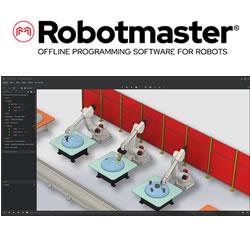From Code to Context: How Spatial AI is Powering the Next Leap in Manufacturing
.jpg)
Beyond the data-driven efficiencies of Industry 4.0, a new paradigm is emerging for manufacturers across every industry: Industry 5.0. This next evolution emphasizes a human-centric, resilient, and sustainable approach, calling for a more symbiotic relationship between human workers and intelligent machines.
The goal is to leverage the precision and tireless nature of automation while keeping human ingenuity, judgment, and creativity at the core of the operation. This vision promises greater flexibility, higher quality, and improved safety, yet a massive, persistent hurdle stands in the way, particularly for small to mid-sized manufacturers: the high cost and debilitating complexity of industrial robotics.
For decades, deploying and reprogramming industrial robots has been a task reserved for highly specialized, six-figure engineers. Setting up a new task—be it an inspection route or a part manipulation sequence—can take hours, days, or even weeks of meticulous, line-by-line coding and calibration. This lengthy, expensive process makes automation uneconomical for short-run production cycles or high-mix, low-volume scenarios, effectively creating a technological moat that keeps advanced automation out of reach for a vast segment of the industrial market.
However, a confluence of technologies—namely Spatial AI and Mixed Reality (XR)—is poised to shatter this status quo, fundamentally changing the economics and accessibility of industrial automation and shrinking a multi-hour robotics setup to mere minutes.
The Shift to "Spatial Intelligence"
The core limitation of traditional industrial robotics is a lack of real-world context. A robot knows where its own joints are, but it doesn't intuitively "know" the factory floor. It operates in a rigid, pre-programmed void. This is where the powerful combination of Artificial Intelligence and Mixed Reality steps in to create a new layer of capability known as Spatial AI.
Spatial AI goes far beyond a static digital twin. It involves creating a persistent, dynamic, and real-time map of the physical factory environment—a living digital blueprint. Mixed Reality devices, such as industrial-grade headsets or powerful tablets, use an array of cameras and sensors to rapidly ingest and process three-dimensional data from the real world. AI algorithms then process this data to understand the semantic meaning of the physical space.
This process gives the robot its crucial missing piece: intelligence about its spatial reality. It means the robot knows where the incoming workpiece is, where the fixtures are, where the safety zone ends, and, crucially, where the human operator is standing. This real-time, persistent map allows robots to transition from operating in a structured, caged-off box to functioning intelligently and safely in the dynamic, often unpredictable environment of a real-world industrial floor. This new intelligence is the necessary foundation for truly flexible and collaborative automation.
A New Mechanism for Democratization
The real breakthrough lies in how Spatial AI translates this spatial understanding into actionable robotics path planning. The industry is moving away from the paradigm of the specialist coder and toward a model of intuitive, visual guidance. This is the democratization mechanism that promises to unleash automation.
Imagine an operator—who is an expert in their craft, but not in robotics programming—donning a simple hands-free mixed reality device or using a tablet. With the Spatial AI engine running, the operator can instantaneously map a new workspace simply by walking through it. The system then automatically identifies and understands complex, variable-geometry objects that would stump a traditional system—an aircraft wing, a large dome-shaped pressure vessel, or an oddly shaped casting.
To program an inspection task, the operator no longer needs to write code. Instead, they can simply visually point to the exact area on the physical object where the robot needs to perform an X-ray scan, a thermal inspection, or a measurement. The operator effectively "teaches" the robot by demonstrating the intent in the real world.
The Spatial AI engine instantaneously translates this visual, human-centric intent into a complete, collision-free robot path and motion plan. What once took hours of specialized coding is now accomplished in under five minutes through an intuitive visual interface. This radically simplifies the process, making advanced automation a tool for the skilled technician, not just the PhD engineer.
The Industry 5.0 Impact
The practical impact of this "5-minute setup" is immense and directly fuels the goals of Industry 5.0. By shifting the automation barrier from highly specialized code to intuitive visual guidance, manufacturers realize immediate and significant benefits.
First, it dramatically lowers the technological barrier to entry. Small and mid-sized enterprises can now justify the cost of automation because the time and expertise required for setup and changeover are negligible. This accelerates the adoption of automation across the supply chain, strengthening the resilience that Industry 5.0 demands.
Second, it profoundly improves operator safety and quality. Collaborative robots equipped with Spatial AI can safely work alongside humans because they are constantly aware of the shared workspace, dynamically adjusting their speed and path to prevent collisions. For inspection tasks, the precision of a visually guided robot exceeds human variability, leading to a consistently higher quality output and reduced rework.
Finally, and most importantly, it fosters a human-machine collaboration that elevates the role of the worker. Liberated from the monotonous, dangerous, or highly repetitive tasks, the human operator can focus on judgment, troubleshooting, and continuous process improvement—the unique skills that drive innovation and sustainability.
Spatial AI is not merely a theoretical leap in digital twin technology; it is a concrete, actionable technology that is delivering immediate, impactful change on the factory floor. By simplifying complexity and driving setup time down to minutes, this technology is the essential accelerator that makes advanced industrial automation truly accessible to all, marking the definitive arrival of the human-centric, high-efficiency world of Industry 5.0.
Dijam Panigrahi is Co-founder and COO of GridRaster Inc., a leading provider of cloud-based platforms that power compelling high-quality digital twin experiences on mobile devices for enterprises. For more information, please visit www.gridraster.com.
Featured Product

